Comeback or Crisis? How Long Is Too Long to Stay in the Fight Game?
By Billie Sloane, IFL TV
It’s the age-old story: the fighter who just can’t walk away. The final bell sounds, the gloves are hung up… until they’re not. A few years later, the training videos start trickling out on social media, the whispers of a comeback grow louder, and before you know it, a former world champion is back in the ring with a licence in one hand and nostalgia in the other. But how long is too long? When does a comeback cross the line from inspirational to irresponsible?
We’ve seen it time and again. Fighters in their late 40s or even 50s stepping back between the ropes, hoping for one last taste of glory—or one last payday. But should the sport draw a line in the sand? Should there be a maximum age limit to compete? And is it time to introduce age categories, just like weight divisions, to ensure fairness and safety?
Let’s unpack it.
The Romantic Return: Why Fans (and Fighters) Love a Comeback
Let’s not pretend we don’t love a comeback. Boxing is theatre, and nothing draws a crowd quite like a fighter defying time to chase that final shot at greatness. Think George Foreman, who reclaimed a heavyweight title at 45. Think Bernard Hopkins, fighting competitively into his 50s. These men became symbols of longevity, of experience triumphing over youth.
And it’s not just about belts. For some, it’s about rewriting the ending. Carl Froch has said publicly he’s occasionally tempted to return, just for closure on his terms. The lure of the ring is strong. The roar of the crowd, the lights, the purpose—how do you walk away from that?
Comebacks can inspire. They can offer redemption. And in some cases, they can remind us that experience is a weapon as dangerous as any right hook.
But let’s not be blinded by the romance. Because for every fairytale return, there’s a harsh reality waiting in the shadows.
The Danger Zone: When Comebacks Become a Health Hazard
Boxing isn’t tennis. You’re not volleying balls—you’re absorbing punches. And when a fighter well past their prime steps in with a fresh-faced, 20-something opponent, is that really a fair contest—or a sanctioned beating?
We’ve seen legends reduced to shadows of themselves, chasing old glories while their reflexes, footwork and punch resistance betray them. Evander Holyfield’s return at 58 against Vitor Belfort was labelled “heartbreaking” by fans and media alike—he looked every bit his age, and the result was as predictable as it was painful to watch.
Let’s be blunt: punches don’t bounce off 50-year-old brains the way they do at 25. Reaction times slow. Cuts take longer to heal. Knockouts can do far more lasting damage. So why do we let it continue? Shouldn’t there be a point where someone—sanctioning bodies, commissions, the sport itself—says enough is enough?
Would we let a 55-year-old debutant step into the octagon for their first MMA bout? Of course not. But if you’re a boxing legend with a famous name and a willing opponent, suddenly it’s fine?
And here’s the real kicker: when a younger fighter agrees to face an ageing opponent, do we question them enough? Is it fair game—or does it tarnish their own resume?
Is It Time for Age Categories in Boxing?
If boxing can have weight divisions to ensure fair play, why not age divisions too? Masters tournaments exist in amateur boxing for fighters over 35. Could the pro game adopt something similar?
Imagine a "Legends Division" for fighters over 45—where experience matches experience, and the playing field is levelled. It keeps ageing fighters away from prime, hungry contenders while giving them a platform to compete safely.
Would it water down the sport? Maybe. But would it protect fighters from mismatches and prevent PR nightmares like Holyfield-Belfort? Absolutely.
And should there be a maximum age limit for pro bouts altogether? Many jurisdictions already have medical tests and reviews for older fighters, but there’s no uniform rule. Is it time for the sport to set a hard limit? Or would that be denying fighters the right to earn a living and make their own choices?
The Promoters and Commissions: Enablers or Protectors?
Let’s talk about responsibility. When a 52-year-old fighter is granted a licence, who signs off? Who benefits? The answer is usually the promoter, the broadcaster, and whoever’s cashing in on the nostalgia.
And let’s not pretend it’s just the older fighters seeking comebacks. Jake Paul was heavily criticised for fighting 47-year-old Anderson Silva. It’s not a new phenomenon—it’s just a new generation doing it.
So should governing bodies do more? Should medical standards be stricter? Should fighters undergo brain scans, reflex tests, and cardiovascular reviews before being allowed anywhere near a sanctioned bout past a certain age?
Or does that strip away personal freedom? Shouldn’t fighters, like any other adult, be able to make their own choices—even if those choices are dangerous?
The Reality Beneath the Romance
Here’s the truth that no one wants to say out loud: many of these comebacks are about money. Fighters often leave the sport with little financial stability. A bad deal here, a bad investment there—and suddenly, a 50-year-old man is lacing up the gloves again because he has no other way to pay the bills.
We celebrate the courage, but we rarely talk about the desperation.
And maybe that’s the biggest question of all: if boxing did a better job protecting its fighters financially, would we even be having this conversation?
The Final Bell
So what do we do? Ban comeback fights after a certain age? Create age-based divisions? Or leave it alone and let the sport police itself?
Boxing thrives on drama. Comebacks will always sell. But is there a point where bravery turns into recklessness, where legacy turns into liability?
Perhaps the better question is this: should we be celebrating these return stories—or asking why they’re even necessary in the first place?

